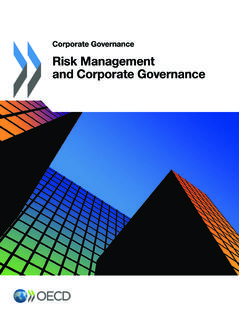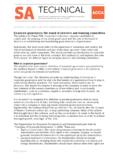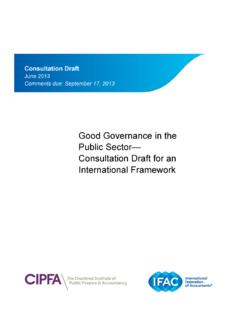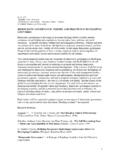Transcription of Effective Data Governance - infosys.digital
1 AbstractData Governance is no more just another item that is good to talk about and nice to have, for global data management organizations. This PoV looks into why data Governance is now on the core agenda of next-generation organizations, and how they can implement it in the most Effective data GovernanceWhy is data Governance important and challenging now? data has grown significantly Over time the desire and capability of organizations, to collect and process data has increased manifold. some of the facts that came out in various analyst surveys and research suggest that: Structured data is growing by over 40% every year Traditional content types, including unstructured data , are growing by up to 80% every year[1] Global data will grow to 40 zettabytes (ZB) by 2020 [2] 85% of this data growth is expected to come from new types; with machine-generated data being projected to increase 15 times by 2020[2]Variety of data and increase in sandboxing culture The next-generation analytics utilize data from all kinds of social networks and blogospheres, machine-generated data , Omniture / clickstream data , as well as customer data from credit management and loyalty management.
2 Alongside this, organizations have now set up sandboxes, pilot environments, and adopted data discovery tools and self-service tools. such data proliferation and the steep increase in data consumption applications demands stringent and Effective data stringent regulations and complianceThe growing regulatory and compliance requirements are making Effective data Governance a must have for industries like financial services and healthcare. The regulatory requirements are now more demanding around data privacy, personal information protection, data security, data lineage, and historical data . This makes data Governance top priority for chief information Officers (ciOs). in fact, a survey by Gartner suggested that by 2016, 20% of CIOs in regulated industries would lose their jobs for failing to implement the discipline of information Governance , successfully [3].
3 data to insights to actions: Need for accurate informationToday s managers use data for decisions and actions. in our experience, many managers feel that the data they are accessing is inaccurate or incomplete, and hence, both confidence and adoption of business intelligence and analytics systems is low. Hence, data Governance initiatives need to generate good confidence in the data managers see and use for decision-making. What are organizations doing to establish Effective data Governance ? Role of the chief data officer (CDO) Gartner predicts that 50% of all companies in regulated industries will have a cDO by 2017 [4]. The cDO will be responsible for enterprise data management, enterprise data Governance , data consumption applications like data warehousing, business intelligence and analytics systems, data quality, metadata management, master data management, data strategy, and data life cycle.
4 Collaborative data Governance Organizationsit is important for chief data Officers to engage the right teams in the data Governance Organization, to align data Governance and business goals. Business teams are important to define vision, identify data to be governed, support the implementation of DG policies, while actively participating in change management and monitoring. iT teams are responsible for the management of data and measurement of data quality, as well as collection and management of metadata and master data . They also provide tools and technologies for implementation of the related tools and Document 2015 infosys Limitedexternal Document 2015 infosys LimitedReliability Stronger and e ective data Governance policies, standards, and procedures Better accountability and data -ownership improves trust and con dence in data being reported both externally and internally Enable better quality information delivery and analyticsTraceability End-to-End data lineage and traceability, enabling better audit controls Capability to respond to changes rapidly through comprehensive impact analysis Improve quality, consistency.
5 And usability of master and reference data across segmentsAuthenticity Consistent consumption of data from authoritative data assets that are certi ed for authenticity Better understanding of data de nitions, promoting consistent usage Robust quality controls across the data life cycleKEY BENEFITSA ccountabilityFor DataBusiness AgilityBetterComplianceIT AgilityStrongerInsightsTypical data Governance Org Structure SteeringCommittee data GovernanceCouncil DataStandards Group Delivery /Execution Group BU Sr. OwnersData StewardData Custodians Key SMEs Set strategy and direction for overall data products Approve funding and resource allocation from BUs Prioritize adoption of enterprise data capabilities Responsible for understanding data modeling, tracking usage, access, and implementation Ensure data is available / accessible, well-performing, and recoverable Ultimate Business Authority for the data they own Accountable for data de nition, usage guidelines, policies, and cost Support data Governance and standards teams Develop investment recommendations for Exec.
6 Management review / approval Ensure data -related work is performed according to operating procedures Determine usage permissions and policies Liaison between business and technology around data issues and questions Identify, de ne, and standardize data elementsFigure 1: Role of Business Teams in data GovernanceFigure 2: Benefits of Seamless data GovernanceArticulate tangible benefits from data Governance initiatives in order to keep all the stakeholders engaged and ensure continuous investments in data Governance initiatives, it is important to articulate the value generated by data Governance initiatives via the right metrics. A dashboard with relevant metrics can be an easy tool to assess the impact of data Governance initiatives, such as improvement in data quality parameters, improvement in dollar-value impact because of improved data quality, and the ability to rationalize enterprise metrics to data definition standardization.
7 Such tools play an important role in monitoring and controlling adherence to the data Governance policies. Sum of parts is greater than the whole seamless data governanceOrganizations are now looking at data Governance holistically. The data Governance strategy includes policy and rules for data quality management, metadata management, master data management, as well as data security. The implementation of each of these individual disciplines presents the intended benefits. However, data Governance strategies and implementations that drive common goals and integrate outcomes across these disciplines enjoy benefits like improved reliability, traceability, and authenticity of data . This will also provide a common communication platform across all the Document 2015 Infosys LimitedExternal Document 2015 Infosys LimitedBig data user ratings are replacing traditional data quality (DQ) metrics ratings by data consumers are replacing traditional means of measuring data accuracy for non-traditional data such as sentiments and opinions.
8 Most of the leading data platform providers such as cloudera, Hortonworks, and informatica (BDe) offer ways of capturing the usage of data from data lakes and user ratings about the usefulness and quality of the data Governance framework including processes, organization, and Infosys data Governance technology solution. Setting data life cycle management quality assessment, pro ling, monitoring, transformation framework, and toolkit backed up by pre-built solutions and Infosys deep experience on master data management implementations, and unique , accelerators backed up by deep competency in industry-leading tools and data security across the enterprise with cost-e ective, scalable solution, ensuring data protection and privacy, as a Assessment Toolkit to identify optimization areas in data landscape, redundancy, simpli cation, and data life cycle managementInfosys O erings for E ective data GovernanceEnterprise data GovernanceData Quality ManagementMaster data ManagementMetadata ManagementData ProtectionData Strategy & DiagnosticsFigure 3.
9 Effective data Governance @ InfosysThe focus now turns to the tools and technologies to implement and ensure compliance with data Governance requirements in accordance to business access. infosys data Governance solution offers a robust framework and technology solutions that leverage partnerships with leading product vendors in this data Governance at infosys infosys holistic service offerings help next-generation organizations to implement Effective data goal of data Governance initiative is to manage data for delivering timely, trustworthy, and relevant information to make informed business decisions. However, data Governance is not only about data , but also about enabling clear ownership, business rules, operational requirements, tools and business processes, easy decision-making process, stakeholder interaction, and business an enterprise establishes the above process of enabling informed business decisions as the collective aim of data Governance , it becomes significantly easier to define the goals and priorities for any initiative.
10 Good data Governance paves the way for enterprise policies, people, and processes to launch that initiative. External Document 2015 Infosys LimitedExternal Document 2015 Infosys LimitedFigure 4: Infosys data Governance FrameworkPeople- RACI data Owners / Custodians, Stewards IT Solution Technologists data Creators and ConsumersExecution Model Scope and Mandate Centralized / Federated Funding and BudgetingProcesses and Policies Standardization Definition, and Reuse data Quality Mgmt IT Systems CRUD SDLC Management Tools and Technologies Metadata / data Quality Classification, Security Audits, and Masking Reference and Master DataMeasured By Efficiency and Efficacy KPIs / SLAs / MetricsInfosys data Governance Framework with measurable KPIs efficiency and efficacy This framework helps next-generation organizations to assess the data Governance maturity and needs, define the strategy accordingly.






